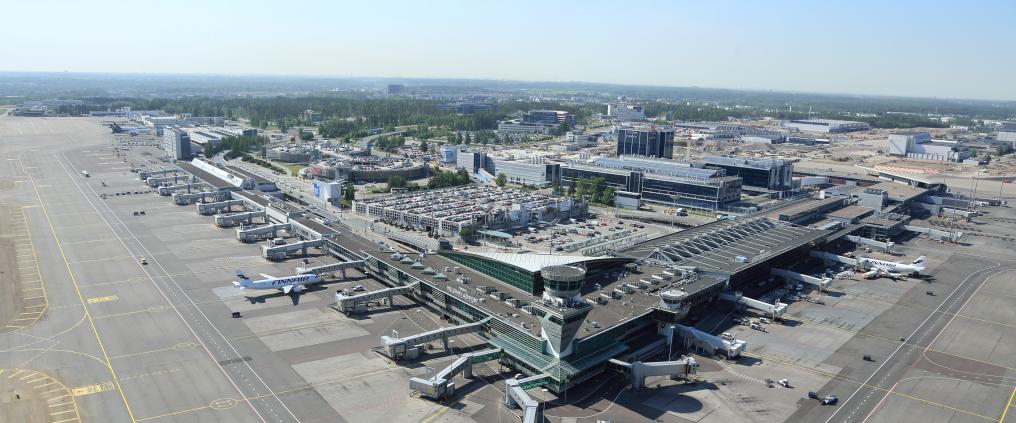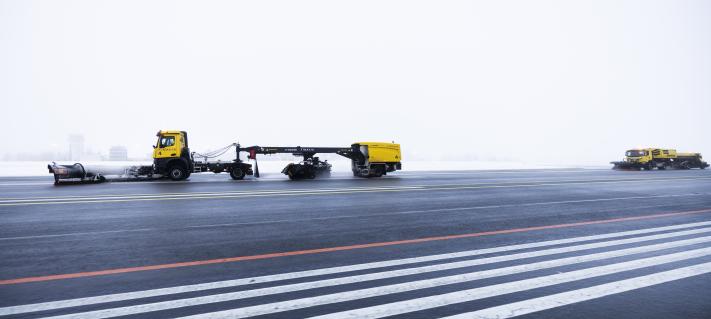1. Solar power plant on the rooftop
Since Summer 2017, Helsinki Airport has had its own solar power plant. Located on the rooftop of the terminal 2, the power plant will be expanded to cover the West pier of the terminal 2, currently under construction.
When at full capacity, the solar power plant will cover 10 per cent of the new terminals’ electricity needs. The plant will be capable of generating 500 kWp at its peak capacity.
“The solar power plant at Helsinki Airport will be one of the largest solar power units in Finland, and the largest plant located on an airport rooftop in the Nordics,” says Johanna Kara, Environmental Specialist at Finavia, the Finnish Airport Operator.
Installing solar panels on the airport rooftop requires expert knowledge and capabilities to ensure that the panels do not reflect light in a way that could distract pilots flying over the airport.
“We plan to share the data about the solar plant’s production capacity with our passengers during 2018.”
2. Apron buses run on waste-based diesel
The apron buses transporting passengers between the terminal and planes at Helsinki Airport run on renewable diesel, made 100 per cent from waste. Using renewable diesel cuts down up to 90 per cent of carbon dioxide emissions compared to regular diesel.
“Globally, few airports have begun to use renewable diesel. We have an advantage in the fact that it is produced ‘right around the corner’, at Neste refinery in Porvoo,” Kara explains.
The idea is that by the end of 2018, all of Finavia’s diesel equipment will use renewable diesel.
“Many of our snowplows and brush blowers still use regular fuel", Kara points out.
3.Lighting changed to LED lamps
Whenever lighting is renewed at Helsinki Airport, Finavia changes the old lighting and fixtures to LED lamps. LEDs are energy-efficient and lower energy costs. They also offer other benefits, for example LEDs light up instantly and are more durable.
“We use LEDs wherever possible – and they are suitable for many purposes,” Kara says.
Energy cost savings have been proven for example in the P5 parking building. When the lighting was updated to LEDs, the amount of energy used for lighting in the structure was reduced by 85%
Helsinki Airport also uses smart guidance for lighting to save energy: motion sensor lights are used wherever possible.
4. Wind power and compensating emissions
At Helsinki Airport, Finavia uses wind power purchased from Nordic electricity markets. However, as airport operations still create emissions, carbon neutrality is finally achieved by offsetting residual emissions. In other words, Finavia acquires carbon offsets from the voluntary carbon market to cover its emissions which are unavoidable. During 2016, Helsinki Airport’s emissions were offset by emissions reduction units from wind power and biogas projects in India.
5. Engaging other stakeholders to reducing emissions
Finavia has been involved in the emissions reduction program of the international airport organization ACA (Airport Carbon Accreditation) since 2011. With Helsinki Airport being recognized as officially carbon neutral, Finavia also has the responsibility to be aware of how other stakeholders at the airport are acting in relation to reducing emissions from their operations and advancing sustainable development where possible.
“We are in continuous dialogue with airlines and ground handling companies, and try to find ways in which to support them in making decisions that help to further reduce,” Kara says.
There is a wide range of companies operating at the airport from catering and cleaning services to aircraft fuelling and baggage handling. The companies that produce the ground handling and passenger services also use many different types machines and work equipment. Most of these are switching to electric power. For instance, electric pushback tractors are already used for moving aircraft.
The entire aviation industry benefits from reducing emissions across the industry.
As Finavia is also a large buyer of products and services, it takes environmental and other sustainability factors into consideration in its procurement practices.
Read about the aviation industry’s actions against climate change



